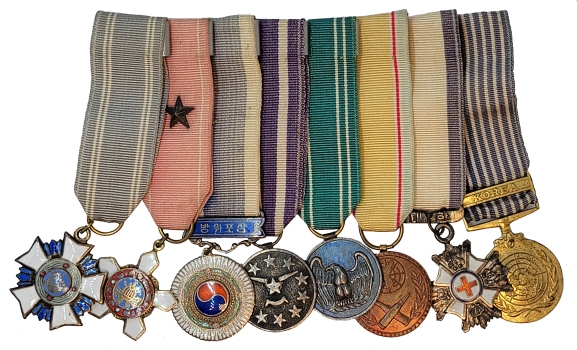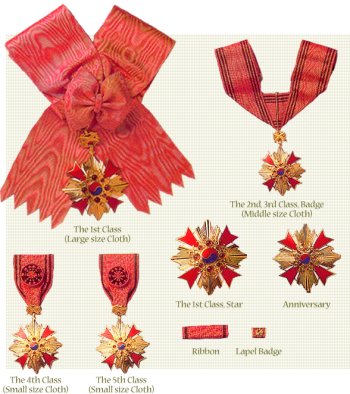
Order of Military Merit, Chungmu
Order of Military Merit, Hwarang with Gold Star
Defense Merit Medal
10 year Anniversary of the Military Founding
Guerrilla Warfare Service Medal
Korean War Service Medal
Red Cross Membership Medal
United Nations Medal
The history of the Republic of Korea’s Award System is extremely complex. Between the Japanese surrender on Aug. 15th, 1945 and the creation of the Republic of Korea’s first Orders and Merit Medals in 1949, there were a number of awards created. However, because they were not awarded by the central government of the Republic of Korea, but by various departments and ministries, such as the Korean National Police or the Ministry of Defense, none of these awards appear in any official ROK publications. When the Korean War erupted on June 25th, 1950, the government found a need to create several new orders to reward the foreigners who came to Korea’s aid. The Korean Ministry of Patriots and Veterans Affairs believes that 1,957,733 foreigners came to Korea’s aid during the War. This initial system of Orders and Merit Medals was created piecemeal and exhibits a certain degree of naïveté.
After the war, the Award System remained fairly static until 1961, when Park Chung Hee took over the administration of the country. Under his leadership, the Korean award system was expanded. Some of the new Orders were for the military, while others were aimed at bolstering the country, both internally and externally. Probably the most difficult period to understand occurred in the late 60s and early 70s. There were design changes to almost every Order/Medal in 1967, 1969 and in 1971. In 1972, a referendum amended the Korean Constitution, which is now referred to as the Yushin (Revitalizing Reforms) Constitution. As part of this revitalizing effort, the Korean Government reviewed its Award System, and in January 1973, several new Orders and Merit Medals were created. The only major change, since then, has been the creation of an Order for Science and Technology in January 2001.
Elements of the Current Award System
ORDERS (훈장 Hun Jang) are the highest and most coveted awards issued by the Republic of Korea. Currently, there are 12 different Orders, the last one being established in 2001. The highest Order, the Grand Order of Mugunghwa, is a single class Order and is reserved for the President of Korea, foreign Heads of State and their spouses. The Order of Diplomatic Merit, is a five-class Order, but the first class has two different grades, one for Korean diplomats and one, which is awarded to foreign diplomats. The remaining 10 orders are all composed of five classes.

The standard Korean Order is generally composed of:
- A First Class on a sash with a breast star.
- A Second Class on a cravat and a slightly smaller breast star.
- A Third Class also on a cravat but without a breast star.
- The Fourth and Fifth Classes are standard breast medals.
However, variations do exist, for example:
- The current Order of National Foundation has a sash for both the First and Second Classes. It also has breast stars for the first three classes.
- The First Class of the Order of Diplomatic Service is currently divided into two grades, both of which have sashes and breast stars.
- Beginning in 1967, there were a number of Orders that had smaller 1st and 2nd Classes specifically sized for women. However, the smaller sizes were felt to be discriminatory and were dropped in 2016.
MERIT MEDALS (보장 Po Jang) are that group of awards just below Orders. These are often referred to as the “6th class” of the Orders. The term is incorrect, but nevertheless, helpful in explaining their importance in the overall system. In Korean publications, they are referred to, in English, as either “Medals of Merit” or as “Medals of Honor”. In all Korean publications and websites, they are always listed separately from the Orders. The first Merit Medals were created in 1949. They have undergone significant change since then. Currently, there are 12 Merit Medals in use. The last one being established in Jan. 2001.
COMMENDATIONS (표창 Pyo Chang) are the third-highest group of awards. They are issued by the President of the Republic of Korea to individuals and organizations that have made outstanding contributions to the nation. These commendations include the Presidential Citation, the Presidential Unit Citation and the Presidential Prize. In addition, the Prime Minister also has a Prime Ministerial Citation, a Unit Citation and a Prize. There are a number of other government ministries that have commendation systems. Unfortunately, until I can gather more information, most of these other systems are currently beyond the scope of this website.
MEDALS (기장 Ki Jang) are at the bottom level of the Korean award system. These are the various commemorative medals, war service medals, campaign, and other miscellaneous medals. The Decorations and Awards Division of the Ministry of Government Administration and Home Affairs strictly controls Korean Orders, Merit Medals, and Presidential & Prime Ministerial Commendations, but they have never controlled Ki Jang. If you want to get technical, the Korean government refers to Ki Jang as ‘Badges’ and they are not part of the core awards of the government. You will find incidences where the ‘central’ government states that they only have Orders, Medals of Merit, and Commendations (Presidential and Prime Ministerial) but no Badges. It is not unusual to find media information where they refer to a particular medal as a badge. The administration of Ki Jang medals/badges is controlled by various ministries and bureaus within the government, which is often confusing. For example, several awards for the Police were originally controlled by the Ministry of Defense. Consequently, it is very difficult to obtain any information. Most of the government bureaus simply do not want to be bothered, and will not provide any assistance. I have a great deal of information on these medals/badges, but there is still much more that needs to be uncovered. Since this website is mostly directed towards non-Koreans, I generally describe Ki Jang as Medals.
OTHER TYPES OF AWARDS are used by the Korean government. There are generally two types of this award, one being a “Letters of Appreciation” 감사장, and another being some type of memento given to commemorate a person’s visit. Probably the ultimate award in this last category is a “Key to the City”.
